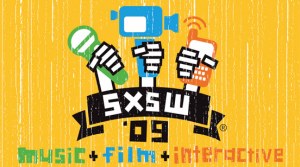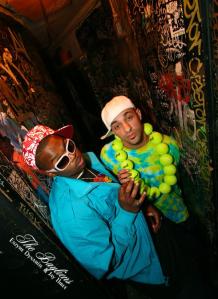In 2006, Zion I released their album Break A Dawn, an album previously released only in Japan and brought stateside following the release of their collaboration with The Grouch, Heroes in the City of Dope. And then, radio silence. Without question the group was staying busy with live performances, interviews, AmpLive’s foray into remix work with the Rainydayz Remixes of Radiohead’s In Rainbows, but the gap between Break A Dawn and tomorrow’s release of The Take Over has been the longest drought of new Zion I material since the gap between 2000’s Mind Over Matter and their sophomore 2003 release Deep Water Slang. And the good news? The Take Over shows what ten years of maturity, musical comfort and genre influence can do to two people dedicated to their craft. The bad news? It clocks in at under 50 minutes, and when it ends, you can’t help but wish there was more.
While The Take Over doesn’t carry with it the same continuity of thought that made Mind Over Matter an intro to outro listen, it does bring the most eclectic genre influences into the music since that album. AmpLive’s creativity with his hip-hop and stunning ability to incorporate other genres helps create a musical backdrop for Zumbi’s lyrics that transcend plain hip-hop or rap. Following the intro, “Geek to the Beat” kicks off the album with a mixture of tribal drums and background chant sounds that are mingled with electro synths and heavy 808s. While it would be very easy for other artists to fall into the trap of using one of these sounds at the expense of the others, Amp has managed to find the balance, alternating between the very simple beat and chants during the verse and then bringing in a heavier electric feel for the chorus. The video below has a snippet of the song performed live on Friday night in Oakland.
“Takeover” follows “Geek to the Beat” and provides a much more traditional hip-hop sound. Amp brings in a boom-bap beat with simple keys in the background and a cut up sample that creates a feel of building in the song while you shrug your shoulders to the sample and then feel the beat come back underneath. Zumbi sounds effortless in his lyrics, and as it goes to chorus, the “takeover” sample mixes with undulating synths and a soulful sounding male vocalist sample. As the song fades and goes to outro, Amp’s musical skills are once again on showcase with a funky electro sound that sets up one of the singles off the album, “DJ DJ.”
This track is certainly one of the more out there cuts on the album as it uses techno and fast paced electro sounds with a chorus snippet in Spanish provided by Deuce Eclipse. Amp on here pays homage to his craft by sprinkling in something of almost anything he can find, including 80’s synth work that could have worked in almost any dance hall. What is perhaps most exciting about this track is that it goes in so many different directions, yet the potential for the evolution of the song is further enhanced by the fact that the group has released the stems to the songs online for fans to remix their own versions. Below is a brief clip of their performance of “DJ DJ” from Friday night.
This goes into one of the most solid songs on the album, “Antenna” featuring Amp’s main collaborator on the Radiohead remixes, Codany Holiday. On this track, Holiday’s refrain of “make me feel brand new” sounds at once both current and retro, a heartfelt line used more as hook than as chorus. What’s fantastic about it is that Zumbi appears to have felt it too as he structures his verses around Holiday’s hook, the simple and in places sparse beat and Amp’s synth work which here sound like falling sheets of rain. The result is a reflective song about Zumbi’s current situation and thoughts, with ascending vocoder sounding samples through the chorus. The electro remix and distortion at the tail end of the song helps to break it down before leaving you with the full beat and hook as it trails out. Video of Friday’s performance of the beginning of this song below.
From there we go into the track duo of “Caged Bird Pt. 1” featuring Brother Ali and “In the Mornin’ (Caged Bird Pt. 2).” These two tracks work as contrasting pieces. The uptempo and refreshing strings provide the melody for a moving and full sounding hip-hop track with a sample-heavy chorus complete with scratch effects and chop up by Amp. The lyrics focus on the idea of something better, and the feeling of the song as a whole is that the street and the cage provide the lyrics, but the music helps open it up and make flight possible. The easy, soulful and bluesy transition to the beginning of pt 2. then gives way to a grimy and deep sound with a much heavier beat. Pt. 2 sounds a bit less hopeful and upbeat than pt. 1, as if pt. 1 is meant to help the caged birds sing, and pt. 2 takes a view of the grind that creates the cage. What’s amazing here is that using the same melody and samples, Amp weaves two completely different songs together with such precision that the split between them is virtually invisible.
“Radio” takes a page from the “Hey Ya” book in that it incorporates a traditional drum/clap sound and acoustic guitar strum, making it sound like a hybrid of hip-hop and 50’s pop music. Zumbi raps about genres and musical evolution on this track that is really a retrospective of radio music and pays homage to the great artists of the past, from Miles Davis to Jimi Hendrix. And on the following track, Amp attempts to bring in a good portion of this retrospective with “Gumbo,” a brief interlude song steeped in horn work and Ragtime influenced jazz. But careful never to let his genre influence tilt too far in one direction, Amp takes the horns and decomposes them to electronic fluctuations of a space jazz variety.
“Country Baked Yams” featuring Devin the Dude is probably the largest departure from Zion I’s signature sounds on the album. It’s a song that will probably do very well on the radio and will have followers, but for me is a bit off. This isn’t to say that I don’t recognize the attempt at something different here and praise the attempt, I just personally don’t think it works. The track is steeped in bubble gum synths and the vocal alteration to a higher pitch makes it feel almost a bit childish. But the chorus is finely crafted with a simple vocal part and a very nice guitar melody with a nice bass line. It’s certainly closer to pop than I’ve heard from Zion I, but as an exploration and experiment, it shows that they’re willing to cross lines and try new things, which I’m never opposed to, even when the results fall short.
“Coastin” featuring K.Flay follows, opening with and carrying through piano that sounds heavily influenced from Amp’s work on Radiohead’s music. The drum clap gives a background for K.Flay’s smooth and somewhat smoky voice and the lyrics by Zumbi sound like he was without question coastin when he wrote it. Amp mixes in some crowd sounds to complete the track. The result is a driving song, perfect for late night with the sunroof open or mid-day with all the windows down. See the clip below:
The last single of the album, “Juicy Juice” comes next, and is the first song that I actually heard off this album a few months ago. The deep 808s and the hyphy feel come out on this Bay Area track that could easily have been placed as the opening track in place of “Geek to the Beat.” The sing-along worthy track, “Peppermint Patty” follows and has the vocal singalong part backed by horns and an eerie melody behind Zumbi’s lyrics. Next is “Bring in the Light” with a grim outlook on the current state of the world, including the bleak but all too familiar thought in the lines “Killing for oil/protest for peace.” Throughout the track, Amp brings jazz touches in, which go full steam ahead in the last minute of the song as he experiments with digitally distorted samples from the song mixed with a jazz piano and more space jazz sounds. While all of the tracks are solid on this album, the outros and interludes are where Amp really shows what kind of producer he is and how well grounded he is musically. They end the album with “Legacy” featuring Ty and Jennifer Johns, a jazz/lounge/pop fusion that draws on some of the tribal beats that show up throughout the album.
All told, there’s something for just about every listener on this album, whether you’ve followed Zion I since Mind Over Matter or if The Take Over is the first time you’re hearing about them (in which case, which rock have you been living under?) Latin, Jazz, Techno, Dance, Blues, Funk and Rock all find a place here, and even when they may not work for a particular listener, the desire to try and experiment with everything can’t be overlooked and is part of what makes the album great. What’s important to note is that while the song by song break down goes to describing what can be found on the album, it doesn’t do justice to the music here. Zumbi’s lyrics are introspective and conscious enough to get better with every listen, and similarly, AmpLive’s production work incorporates so many genres and layers to the musical tapestry he creates here that it’s hard not to constantly pick up new pieces to the sound that you hadn’t heard before. The Take Over drops tomorrow.






